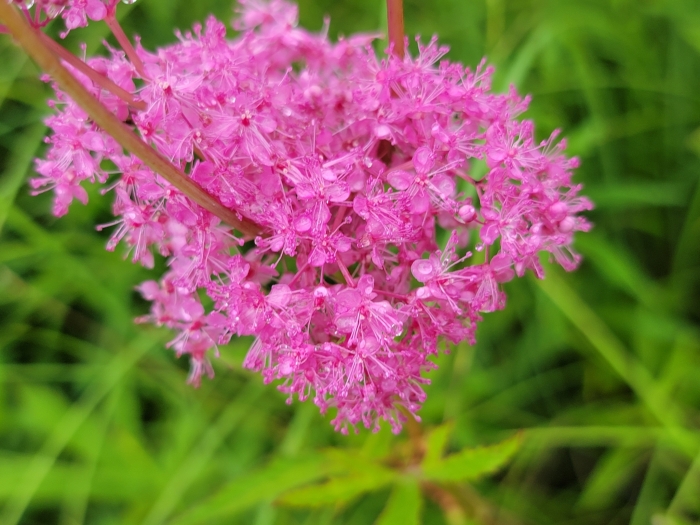Queen Of The Prairie
(Filipendula rubra)
Queen Of The Prairie (Filipendula rubra)
/
/

Elias
CC BY 4.0
Image By:
Elias
Recorded By:
Copyright:
CC BY 4.0
Copyright Notice:
Photo by: Elias | License Type: CC BY 4.0 | License URL: http://creativecommons.org/licenses/by/4.0/ | Rights Holder: Elias | Publisher: iNaturalist | Date Created: 2021-07-11T11:27:58-07:00 |







































































Estimated Native Range
Summary
Filipendula rubra, commonly known as Queen Of The Prairie, is a deciduous perennial herb native to moist meadows, prairie-like areas, and open woodlands in the Central and Eastern United States. It can reach a height of up to 2.5 meters (8 feet) and a width of 1.3 meters (4 feet 3 inches). The plant forms an upright clump with deep green, compound leaves that are fern-like in appearance. From July to August, it produces showy, fragrant, pale pink to deep pink flowers that are small but clustered in large, airy panicles, giving a frothy appearance. These blooms are highly attractive to pollinators such as bees, flies, and beetles.
Queen Of The Prairie is valued for its striking, sweet-scented flowers that resemble lilacs and its ability to attract wildlife. It is often used in naturalistic plantings, borders, and water garden peripheries. While it prefers moist conditions, it can tolerate drier soils in shadier spots. This species is known for its aggressive spreading through creeping roots, which can be a consideration in garden design. It is hardy to USDA zone 2 and requires full sun to part shade, with medium to high water needs and soils with slow to medium drainage. Pruning during drought can rejuvenate the plant’s appearance.CC BY-SA 4.0
Queen Of The Prairie is valued for its striking, sweet-scented flowers that resemble lilacs and its ability to attract wildlife. It is often used in naturalistic plantings, borders, and water garden peripheries. While it prefers moist conditions, it can tolerate drier soils in shadier spots. This species is known for its aggressive spreading through creeping roots, which can be a consideration in garden design. It is hardy to USDA zone 2 and requires full sun to part shade, with medium to high water needs and soils with slow to medium drainage. Pruning during drought can rejuvenate the plant’s appearance.CC BY-SA 4.0
Plant Description
- Plant Type: Herb
- Height: 6-8 feet
- Width: 3-4 feet
- Growth Rate: Moderate
- Flower Color: Pink
- Flowering Season: Summer
- Leaf Retention: Deciduous
Growth Requirements
- Sun: Full Sun, Part Shade
- Water: Medium, High
- Drainage: Slow, Medium
Common Uses
Bee Garden, Bird Garden, Butterfly Garden, Deer Resistant, Fragrant, Low Maintenance, Rabbit Resistant, Showy Flowers, Water Garden
Natural Habitat
Moist meadows, prairie-like areas, and open woodlands
Other Names
Common Names: Queen-Of-The-Prairie, Red Queen-Of-The-Meadow, Rotes Mädesüß, Filipendule Rouge, Amerikanskt Älggräs
Scientific Names: , Filipendula rubra, Spiraea rubra, Filipendula lobata, Spiraea palmata, Thecanisia lobata, Thecanisia ponpurea, Thecanisia purpurea, Ulmaria lobata, Ulmaria rubra,
GBIF Accepted Name: Filipendula rubra (Hill) B.L.Rob.